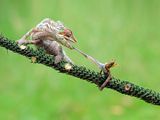Heterotrophs
What Are Heterotrophs: A heterotroph is an organism that consumes other organisms in a food chain.
Chameleon
For upon |Chameleons are a bizarre and colorful example of a heterotroph, an organism that consumes other animals or plants – like this unfortunate cricket – to sustain itself.
A heterotroph is an organism that eats other plants or animals for energy and nutrients. The term stems from the Greek words hetero for “other” and trophy for “nourishment.”
Organisms are characterized into two broad categories based on how they obtain their energy and nutrients: autotrophs and heterotrophs. Autotrophs are known as producers because they are able to make their own food from raw materials and energy. Examples include plants, algae, and some types of bacteria. Heterotrophs are known as consumers because they consume producers or other consumers. Dogs, birds, fish, and humans are all examples of heterotrophs.
Food Chain
Heterotrophs occupy the second and third levels in a food chain, a sequence of organisms that provide energy and nutrients for other organisms. Each food chain consists of three trophic levels, which describe an organism’s role in an ecosystem. Occupying the first trophic level are autotrophs, such as plants and algae. Herbivores—organisms that eat plants—occupy the second level. Carnivores (organisms that eat meat) and omnivores (organisms that eat plants and meat) occupy the third level. Both primary (herbivores) and secondary (carnivores and omnivores) consumers are heterotrophs, while primary producers are autotrophs.
The third type of heterotrophic consumer is a detritivore. These organisms obtain food by feeding on the remains of plants and animals as well as fecal matter. Detritivores play an important role in maintaining a healthy ecosystem by recycling waste. Examples of detritivores include fungi, worms, and insects.
There are two subcategories of heterotrophs: photoheterotrophs and chemoheterotrophs. Photoheterotrophs are organisms that get their energy from light, but must still consume carbon from other organisms, as they cannot utilize carbon dioxide from the air. Chemoheterotrophs, by contrast, get both their energy and carbon from other organisms.
Autotrophs And Heterotrophs
A major difference between autotrophs and heterotrophs is that the former are able to make their own food by photosynthesis whereas the latter cannot. Photosynthesis is a process that involves making glucose (sugar) and oxygen from water and carbon dioxide using energy from sunlight. Autotrophs are able to manufacture energy from the sun, but heterotrophs must rely on other organisms for energy.
Another major difference between autotrophs and heterotroph is that autotrophs have an important pigment called chlorophyll, which enables them to capture the energy of sunlight during photosynthesis, whereas heterotrophs do not. Without this pigment, photosynthesis could not occur.
Heterotrophs benefit from photosynthesis in a variety of ways. They depend on the process for oxygen, which is produced as a byproduct during photosynthesis. Moreover, photosynthesis sustains the autotrophs that heterotrophs depend on to survive. While meat-eating carnivores may not directly depend on photosynthetic plants to survive, they do depend on other animals that consume photosynthetic plants as a food source.

Chameleons are a bizarre and colorful example of a heterotroph, an organism that consumes other animals or plants – like this unfortunate cricket – to sustain itself.
Photograph by kuritafsheen
The article was originally published here.


Comments are closed.